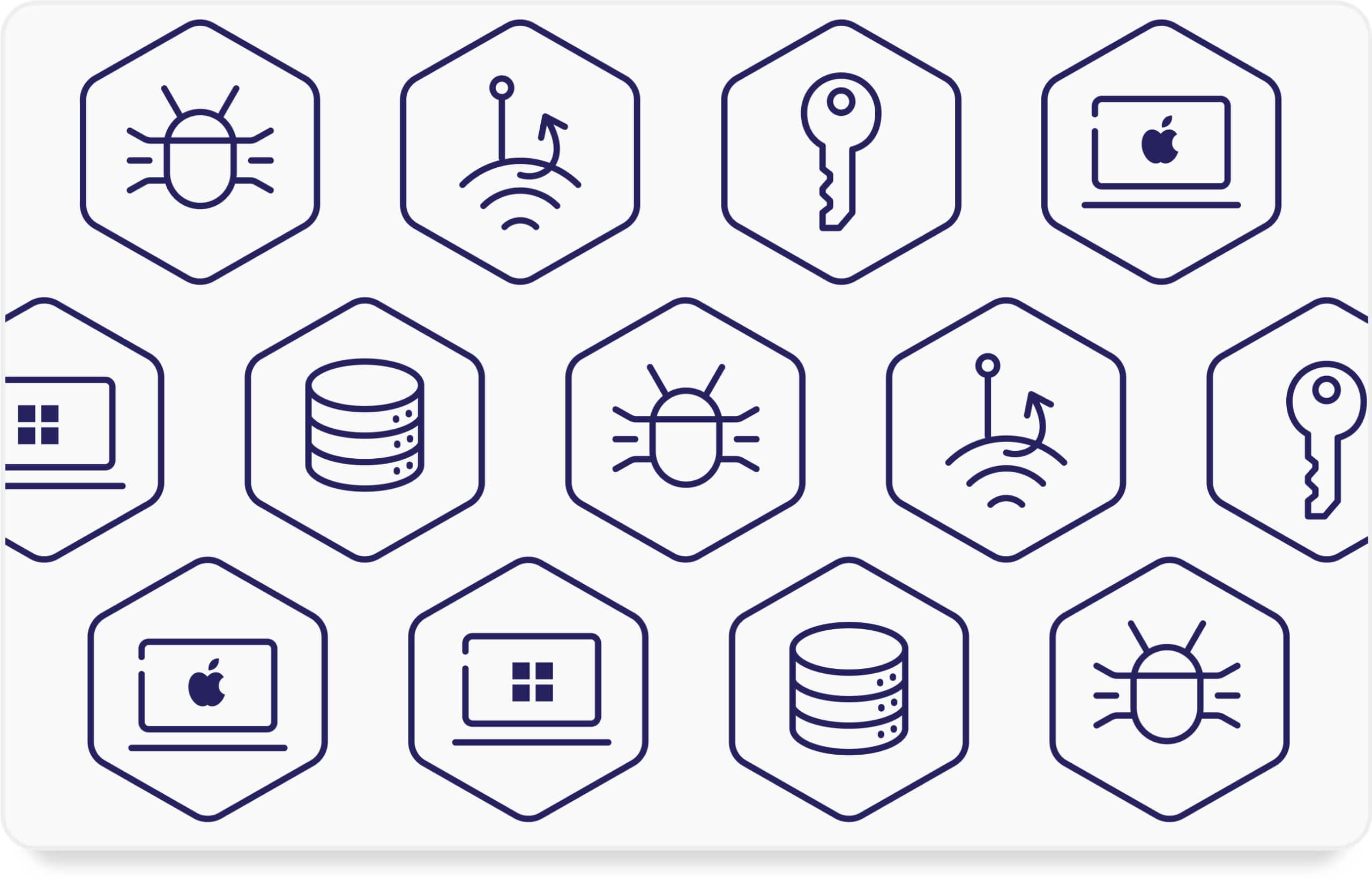Social engineering is a manipulative and manipulative technique used by cyber attackers. The purpose is to exploit human psychology and trick individuals into divulging sensitive information, performing actions, or unintentionally granting unauthorized access to systems. Instead of relying on technical vulnerabilities, social engineering targets human emotions, trust, or lack of awareness to achieve its objectives.
Common tactics include phishing emails, pretexting, baiting, and impersonation, all designed to trick individuals into compromising security protocols or sharing confidential information. Social engineering attacks often exploit trust, authority, urgency, or familiarity to deceive targets, making it crucial for individuals to be vigilant and cautious in their interactions, both online and offline.
Forms/Types of Social Engineering Attacks
Social engineering schemes can take various forms, including psychological manipulation that takes advantage of weak security protocols. Education, awareness, and the implementation of security best practices are essential components of defense against these techniques. Still, it’s also crucial to recognize and understand each of them.
The most common types of social engineering include:
- Phishing: Phishing is a tactic where deceptive emails, messages, or websites, designed to resemble trustworthy sources, are employed to deceive the intended victim. The primary objective is to manipulate people into divulging sensitive information, including passwords, usernames, or financial details.
- Pretexting: Pretexting is all about creating a pretext or a fabricated scenario to manipulate individuals into divulging information. For example, the attacker may pose as a trustworthy entity, such as a coworker or service provider, to gain access to sensitive data.
- Baiting: Baiting entices individuals with something desirable, like a free download or a tempting offer, to lure them into performing an action that compromises security. This could include downloading malicious software or providing login credentials.
- Quizzes and surveys: Sometimes, attackers create quizzes or surveys that seem innocent but actually gather valuable information about individuals. The questions might be designed to extract personal details, security answers, or other sensitive information.
- Impersonation: Impersonation occurs when an attacker pretends to be someone else to gain trust and manipulate individuals. This could involve posing as a colleague, a technical support representative, or another trusted entity to deceive individuals into taking specific actions.
- Tailgating (piggybacking): Tailgating, also known as piggybacking, occurs in a physical setting when an individual follows an authorized person into a restricted area without proper authentication. Attackers may exploit this behavior to gain unauthorized access to secure locations.
- Quid pro quo: Quid pro quo involves offering something in exchange for information. For example, an attacker might pose as an IT support technician and offer assistance in exchange for login credentials.
- Reverse social engineering: In reverse social engineering, the attacker first gains the trust of the target, often through friendly interactions. Once trust is established, the attacker then manipulates the target into providing information or performing actions.
- Online scams and hoaxes: Scams and hoaxes on social media or other online platforms can deceive individuals into clicking on malicious links, sharing personal information, or falling victim to fraudulent schemes.
Imagine you receive a phone call from someone claiming to be from your bank, and they urgently need to verify your account details. They sound official and even know some basic information about you. The attacker on the phone is trying to deceive you into revealing sensitive information by creating a sense of urgency and trust.
Why Should Businesses Care About Social Engineering Tactics?
Social engineering tactics and other manipulative techniques pose significant threats to the cybersecurity and overall operational integrity of businesses, small and big. Let’s now look at a few compelling reasons why businesses should prioritize addressing social engineering.
Reason #1: Data Breach and Confidentiality
Social engineering tactics often aim to trick employees into divulging sensitive information, such as login credentials or proprietary data. A successful social engineering attack can lead to a data breach, compromising the confidentiality of critical business information. Businesses should care about this as it can result in reputational damage, legal consequences, and loss of competitive advantage.
Reason #2: Financial Loss and Fraud Prevention
Social engineering attacks may facilitate fraudulent activities, leading to financial losses for the business. This could include unauthorized fund transfers, fraudulent transactions, or manipulation of financial processes. By addressing social engineering tactics, businesses can mitigate the risk of financial fraud and protect their assets.
Reason #3: Operational Disruption and Business Continuity
Successful social engineering attacks can disrupt normal business operations. For instance, if an employee falls victim to a phishing attack, it could lead to malware infections or unauthorized access, affecting systems and causing downtime. Businesses should prioritize social engineering awareness to ensure operational continuity and minimize disruptions.
Reason #4: Reputational Damage and Trust Erosion
Falling victim to social engineering can result in reputational damage, eroding the trust that clients, partners, and the public have in the business. Whether it’s a successful impersonation, a phishing scam, or a data breach, the fallout can harm the business’s image. Maintaining trust is crucial for long-term success, making social engineering prevention a vital aspect of business strategy.
Reason #5: Compliance with Regulations
Many industries are subject to regulations that mandate the protection of sensitive information. Social engineering attacks can lead to non-compliance with these regulations, exposing businesses to legal consequences and financial penalties. Prioritizing social engineering prevention ensures that businesses meet regulatory requirements, fostering a secure and compliant operating environment.
Social Engineering and Your Broader Cybersecurity Program
Social engineering functions within the broader context of a cybersecurity framework by exploiting human vulnerabilities to bypass technical defenses. Consequently, in a comprehensive cybersecurity strategy, social engineering is often considered a human-centric threat vector that complements technical measures.
By incorporating social engineering considerations into a cybersecurity framework, organizations create a more resilient defense strategy that addresses both technical vulnerabilities and human factors. For instance:
- Considering human elements: While cybersecurity frameworks typically involve robust technical controls, they also acknowledge the human element. Social engineering recognizes that individuals, irrespective of technological safeguards, can be manipulated or deceived. Integrating social engineering awareness into the framework involves educating and training personnel to recognize and resist manipulation attempts.
- Security awareness training: Within a cybersecurity framework, there is often a component dedicated to security awareness training. This involves educating employees about various cyber threats, including social engineering tactics. By creating a security-conscious culture, organizations empower individuals to identify and report potential social engineering attacks, acting as an additional layer of defense.
- Incident response and detection: Social engineering attacks are not always preventable, and organizations need mechanisms to detect and respond effectively. A cybersecurity framework includes incident response protocols that address not only technical breaches but also social engineering incidents. This may involve reporting mechanisms, communication plans, and coordinated responses to mitigate the impact of successful social engineering attempts.
- User authentication and access controls: Social engineering often targets individuals to gain unauthorized access. A cybersecurity framework incorporates strong user authentication and access controls to limit the potential damage caused by compromised credentials obtained through social engineering. This includes principles like least privilege, ensuring that individuals have access only to the resources necessary for their roles.
- Integration with technical defenses: Social engineering awareness aligns with and complements technical defenses. For example, a well-rounded cybersecurity framework may include email filtering to detect phishing attempts. Social engineering education enhances the effectiveness of these technical measures by empowering individuals to recognize and report suspicious activities, contributing to a more resilient cybersecurity posture.
- Continuous monitoring and threat intelligence: Cybersecurity frameworks often involve continuous monitoring of networks and systems. In the context of social engineering, this includes monitoring for unusual user behavior or patterns indicative of manipulation. Threat intelligence gathering may also encompass information about social engineering campaigns, enabling organizations to proactively defend against evolving tactics.
Social engineering also plays a significant role within cybersecurity frameworks and concepts like MITRE ATT&CK, least privilege, and Zero Trust:
- MITRE ATT&CK: MITRE ATT&CK is a framework that outlines tactics, techniques, and procedures (TTPs) employed by adversaries during cyber attacks. Social engineering tactics, such as phishing and pretexting, are integrated into various stages of the attack lifecycle. For instance, an attacker might use social engineering to gather initial access by tricking an employee into clicking a malicious link. Recognizing and defending against social engineering tactics are essential components of a MITRE ATT&CK-aligned cybersecurity strategy.
- Least Privilege: Least Privilege is guided by the principle that individuals or systems should possess the minimum necessary access required to fulfill their tasks. Social engineering attacks frequently seek to elevate privileges or coerce individuals into providing excessive access. Upholding the principle of least privilege enables organizations to mitigate the consequences of successful social engineering attempts, as compromised accounts would have limited access.
- Zero Trust: Zero Trust is a cybersecurity model that challenges the traditional approach of trusting entities inside a network and being suspicious of those outside. Social engineering often seeks to exploit trust relationships, making it a critical consideration within the Zero Trust framework. In a Zero Trust environment, trust is never assumed, and continuous verification is required. Social engineering prevention aligns with the Zero Trust philosophy by emphasizing the need to verify identities and access requests consistently.
Related Systems or Technologies
Several systems and technologies are commonly employed to manage or prevent social engineering attacks. These technologies aim to enhance awareness, strengthen defenses, and empower individuals to recognize and resist manipulation attempts.
Email Filtering and Anti-Phishing Solutions
Email remains a common vector for social engineering attacks, especially phishing. Advanced email filtering solutions and anti-phishing tools help identify and block malicious emails before they reach users’ inboxes. These technologies use various techniques, including pattern recognition, URL analysis, and machine learning, to detect phishing attempts.
Multi-Factor Authentication (MFA)
Multi-Factor Authentication (MFA) enhances security by demanding users to provide multiple forms of identification. Through MFA implementation, organizations can reduce the risk of unauthorized parties gaining access by using compromised credentials acquired through social engineering.
Endpoint Protection and Anti-Malware Software
Endpoint protection solutions include features that combat social engineering-driven malware. These tools employ signature-based detection, behavioral analysis, and heuristics to identify and block malicious software that may be delivered through social engineering tactics.
User Behavior Analytics (UBA)
UBA solutions analyze patterns of user behavior to identify anomalies that may indicate social engineering attempts. By monitoring deviations from typical behavior, these tools can flag suspicious activities, such as unusual login times or access requests.
SIEM systems are designed to collect and analyze log data coming from diverse sources, aiding organizations in correlating information and identifying potential security incidents. SIEM platforms can contribute to recognizing patterns that suggest the use of social engineering techniques, facilitating prompt and effective responses.
Related Regulations or Compliance Goals
Although industry regulations do not typically specify detailed requirements for handling social engineering explicitly, they often include broader mandates related to data protection, privacy, and cybersecurity – all of which indirectly impact how organizations address social engineering threats.
Here are examples of relevant regulations:
- General Data Protection Regulation (GDPR): GDPR focuses on protecting the privacy and personal data of individuals. While it doesn’t explicitly address social engineering, it emphasizes the importance of implementing security measures to safeguard personal data. Organizations under GDPR are expected to have robust security practices, which would naturally involve addressing social engineering threats.
- Payment Card Industry Data Security Standard (PCI DSS): PCI DSS is specifically geared towards organizations that handle payment card transactions. While it primarily focuses on securing cardholder data, it indirectly addresses social engineering by requiring strong access controls, regular security awareness training, and monitoring of access to sensitive information.
- Health Insurance Portability and Accountability Act (HIPAA): HIPAA regulates the handling of protected health information (PHI) in the healthcare industry. While not explicitly mentioning social engineering, it emphasizes the need for comprehensive security measures, which would include safeguards against social engineering attacks that could compromise sensitive health information.
- National Institute of Standards and Technology (NIST) Framework: NIST provides a cybersecurity framework that offers guidelines for improving the cybersecurity posture of organizations. Though it doesn’t specifically address social engineering, the framework emphasizes risk management, continuous monitoring, and incident response, which are relevant to mitigating social engineering threats.
- ISO/IEC 27001: ISO/IEC 27001 is an international standard for information security management systems. While not explicitly focused on social engineering, it requires organizations to identify and manage information security risks. This involves implementing controls that could indirectly address social engineering vulnerabilities.









